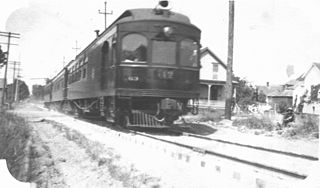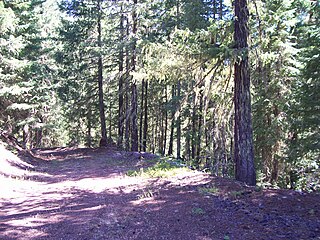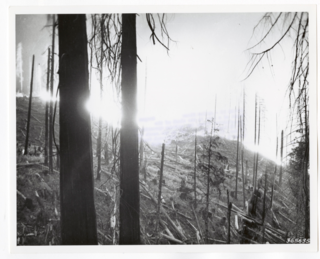
The Interstate Commerce Commission (ICC) was a regulatory agency in the United States created by the Interstate Commerce Act of 1887. The agency's original purpose was to regulate railroads to ensure fair rates, to eliminate rate discrimination, and to regulate other aspects of common carriers, including interstate bus lines and telephone companies. Congress expanded ICC authority to regulate other modes of commerce beginning in 1906. Throughout the 20th century, several of ICC's authorities were transferred to other federal agencies. The ICC was abolished in 1995, and its remaining functions were transferred to the Surface Transportation Board.

The Oregon Electric Railway (OE) was an interurban railroad line in the U.S. state of Oregon that linked Portland to Eugene.

The Portland and Western Railroad is a 516-mile (830 km) Class II railroad serving the U.S. state of Oregon, and is a wholly owned subsidiary of shortline and regional railroad holding company Genesee & Wyoming Inc. The PNWR includes a subsidiary, the Willamette and Pacific Railroad.

The Central Branch Union Pacific Railroad was a railroad in the U.S. state of Kansas. Originally planned as a line from Atchison west into Colorado, and given federal land grants by the Pacific Railway Act of 1862 as one of the branches of the Union Pacific Railroad, it was left with a hanging end at Waterville, Kansas, when the Union Pacific Railway, Eastern Division, with which it was to connect, changed its route. The line was acquired by the Union Pacific through a stock purchase by Jay Gould and leased to the Missouri Pacific Railroad in 1880. In 1909 the Central Branch was merged into the Missouri Pacific; the latter company came back into the Union Pacific system in 1982. In 1991 the remaining trackage west of Frankfort was leased to the Kyle Railroad.

The Oregon Railroad and Navigation Company (OR&N) was a rail and steamboat transport company that operated a rail network of 1,143 miles (1,839 km) running east from Portland, Oregon, United States, to northeastern Oregon, northeastern Washington, and northern Idaho. It operated from 1896 as a consolidation of several smaller railroads.

The Oregon Central Rail Road was the name of two railroad companies in the U.S. state of Oregon, each of which claimed federal land grants that had been assigned to the state in 1866 to assist in building a line from Portland south into California. The "East Side Company" of Salem, supported by businessman Ben Holladay, eventually received the grant for its line east of the Willamette River, and was reorganized in 1870 as the Oregon and California Railroad (O&C), which completed the line in 1887. Portland supported the competing "West Side Company", which only built to McMinnville, and was sold to the O&C in 1880. The O&C was later acquired by the Southern Pacific Company, and mostly remains as part of the Union Pacific Railroad's I-5 Corridor; the West Side line is now operated by the Portland and Western Railroad between Beaverton and Forest Grove.

Oregon Pacific Railroad was a railroad in western Oregon, United States, from 1880 to 1894, when it was sold to the Oregon Central and Eastern Railroad. A substantial part of the Oregon Pacific's abandoned right-of-way is preserved as Oregon Pacific Railroad Linear Historic District.
The following is a brief history of the North American rail system, mainly through major changes to Class I railroads, the largest class by operating revenue.

The Oregon Eastern Railway was a predecessor of the Southern Pacific Company that acquired or built most of the Natron Cutoff in northern California and southern Oregon, United States. It also made surveys and acquired right-of-way in eastern Oregon, which were subsequently sold to Union Pacific Railroad subsidiary Oregon–Washington Railroad and Navigation Company.
The Puget Sound Shore Railroad and successor Northern Pacific and Puget Sound Shore Railroad built a branch line of the Northern Pacific Railroad between Puyallup and Seattle, Washington, U.S., and partially constructed a line around the east side of Lake Washington to Woodinville.
The Chicago and Southern Railroad built a rail line in northeastern Illinois, extending south from Chicago to Thornton. It now mainly forms part of the Grand Trunk Western Railroad, while the north end has been operated by the Atchison, Topeka and Santa Fe Railway, the Illinois Northern Railway, and most recently the Central Illinois Railroad.
Thomas Egenton Hogg (1828–1898) was a master in the Confederate States Navy who participated in raids on Union ships during the American Civil War. He was captured and sentenced to death, but was eventually released from prison, after which he became a businessman and railroad promoter in the U.S. state of Oregon. He worked to build the Oregon Pacific Railroad, though his dream to create a transcontinental railroad with its western terminus on the Oregon Coast was never realized.
Saint Joseph is an unincorporated community in Yamhill County, Oregon, United States. It is located about two miles west of Lafayette near Oregon Route 99W. The area is sometimes known as "St. Joe".
The history of the Southern Pacific ("SP") stretched from 1865 to 1998.

Consolidated Timber Company was an American lumber company that operated a large sawmill near Glenwood, Oregon, circa 1936–1946.

The Forest Grove branch is an abandoned railway line in the state of Oregon, in the United States. It was built by the Oregon Electric Railway and ran 19.1 miles (30.7 km) from Garden Home to Forest Grove via Beaverton and Hillsboro. The MAX Blue Line uses part of the right-of-way between Beaverton and Hillsboro.

The Beaverton and Willsburg Railroad was a railway company in the state of Oregon in the United States. The Southern Pacific established the Beaverton and Willsburg Railroad in 1906 to construct a new cutoff in the vicinity of Portland, Oregon, to run between Beaverton and Milwaukie. The line was completed in 1910 and the company merged into the Southern Pacific in 1916. The cutoff, composed of two separate line segments, remains in use today.

The Milwaukie branch is a railway line in Clackamas County, Oregon, in the United States. It connects the Union Pacific Railroad's Brooklyn Subdivision and Newberg branch. It was originally built in 1910 by the Beaverton and Willsburg Railroad, a subsidiary of the Southern Pacific Transportation Company. The Portland and Western Railroad operates the line.
The Newberg branch is a railway line in the state of Oregon, in the United States. It runs 36 miles (58 km) from Portland to a junction with the West Side branch west of Saint Joseph. It was originally built by the Portland and Willamette Valley Railway, a predecessor of the Southern Pacific Transportation Company.
The Tigard branch is a short railway line on the west side of Portland, Oregon, in the United States. It connects the Union Pacific Railroad's West Side branch and Newberg branch. It was originally built in 1910 by the Beaverton and Willsburg Railroad, a subsidiary of the Southern Pacific Transportation Company. The Portland and Western Railroad operates the line, including the WES Commuter Rail service.












